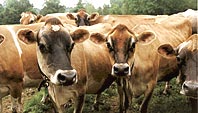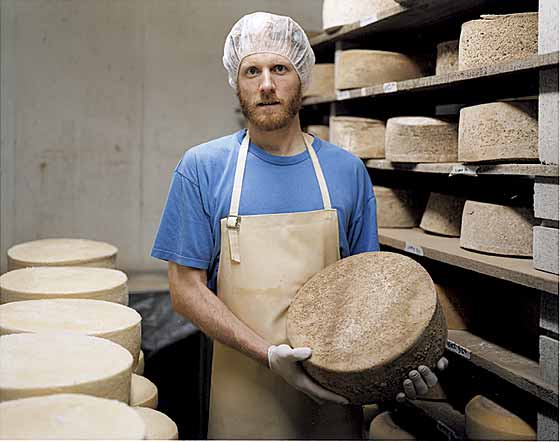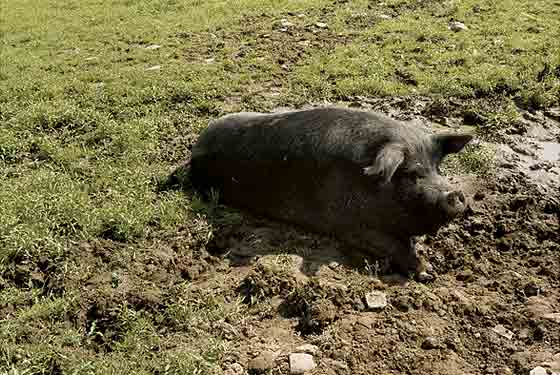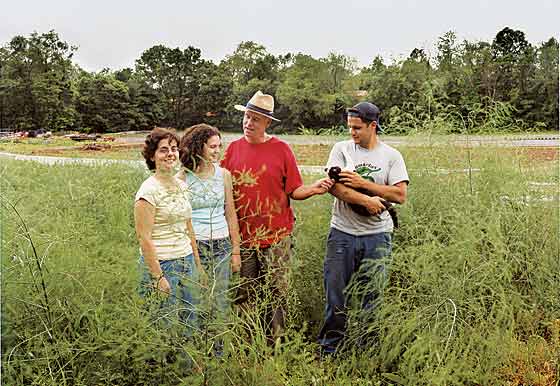
Thirty years ago this week, seven intrepid farmers trucked in produce and plants they’d grown upstate or in Jersey or Long Island and set up makeshift stands in a fenced-in lot on Second Avenue and 59th Street. It was July 17, 1976, and no one knew quite what to expect—not the farmers, who’d been recruited from agriculture associations and roadside stands; not the organizers, Barry Benepe and Bob Lewis, who’d spent months scraping up seed money and hacking through acres of red tape; and not the public, who viewed the spectacle as some sort of bizarre hayseed performance art.
Ron Binaghi Jr., 16 at the time, was there with his father. The way he tells the story, at the end of that very first Greenmarket day, after they had been rapidly depleted of their stock of tomatoes, peppers, and peaches, they headed back to Stokes Farm, their Old Tappan, New Jersey, homestead, slightly dumbstruck. “Is there a famine somewhere in that city?” Binaghi Sr. marveled.
In a way, of course, there was. Before Greenmarket—that inconceivable time predating easy access to Green Zebra tomatoes and garlic scapes—New York wasn’t always a land of agricultural plenty. Even though the city was surrounded by (ever-shrinking) farmland, you’d never know it by the stuff on supermarket shelves. Greenmarket was founded, in large part, to preserve farmland by helping growers sell directly to consumers, bypassing the middlemen who made selling wholesale such a crippling proposition.
Thirty years later, Greenmarket has blossomed, with 179 producers at 45 locations in all five boroughs. Farmers’ fees, dictated by the amount of space they occupy, the location, and the day, make up most of the organization’s operating budget. It’s obvious, especially at this bountiful time of year, and especially at Union Square, the flagship market that celebrates its own 30th anniversary on August 30, what we get out of the program. How about the farmers?
“We make way more money at retail than we did years ago in the wholesale trade,” says Binaghi, who won’t reveal exact figures but says he derives 90 percent of his income from Greenmarket. Nevia No, a partner in Yuno’s Farm with her husband, Kwang Yoo, says that participating in Greenmarket has doubled their income. When she married Yoo, he and his father were wholesaling Asian vegetables they grew on a Riverhead farm to Asian markets. Eight years ago, she persuaded him to let her try her hand at a Brooklyn Greenmarket. “He said, ‘Go ahead, do it on your own. I’ll give you some leftover vegetables,’ ” says No. “I sold $700 on the first day. I came home screaming with excitement.” Four years ago, they moved the farm to New Jersey, and a year later, they quit the wholesale market entirely.
Some of the benefits are less tangible, but no less real. If Greenmarket brings the essence of the country to the asphalt-paved urban jungle, it also helps guarantee that the country stays right where it is. “If it weren’t for Greenmarket, I’d be rich,” jokes Binaghi, whose seventeen Bergen County acres are worth $10 million. “We would have sold the land for houses and retired to an island somewhere, so you could say Greenmarket is directly keeping our land from development.” And it’s no accident that Greenmarket’s lifespan has paralleled the rise of the local and seasonal culinary movement. Way back when, says Binaghi, “some chef said, ‘Here’s some seed, can you grow this stuff for me?’ All right, dopey chef, we’ll grow it for ya. And then the general public starts asking us for specific things. In New York City, there’s such a diverse ethnic population. From the Caribbean they want Caribbean thyme; people from Belgium want good leeks. People in the suburbs don’t even know what leeks are.” Stokes Farm grows about 50 items but is best known for heirloom tomatoes and fresh-cut herbs. “Rosemary put my kids in college.”
On the following pages, we take a closer look at five Greenmarket purveyors in their milieus, so you can see exactly where they’re coming from. Next: Cato Corner Farm, Violet Hill Farm, and Blue Moon Fish

Cato Corner Farm
All-American Cheese
A mother-and-son team take up artisanal cheese-making in the wilds of Connecticut.
In 1999, Mark Gillman joined his mother’s fledgling cheese-making operation after a short stint teaching junior-high-school English. “I only taught for three years, and if you know anyone who’s taught, you know the first couple of years are pretty brutal,” he says. “But I kept all my books—If this doesn’t work out, I thought, I’ll go back to teaching.” So far, so good. That Cato Corner Farm’s gross revenues were around $400,000 last year—70 percent from Greenmarket sales—and should reach half a million this year, which isn’t bad for a small farm with a small staff, might be reason enough for Gillman to put his syllabus into permanent storage. Not that his new life is a breeze. Four days a week are devoted to cheese-making. Gillman’s mother, Elizabeth MacAlister, milks the Jersey cows at 5 A.M. Gillman takes over at 7 A.M. to pump the milk—around 3,000 pounds on a good day, which makes about 300 pounds of cheese. Then there’s the cleanup—the worst part of the job—which takes as long as the cheese-making. But the rewards are abundant. In the best Greenmarket tradition, the cheese is made from the raw milk of 30 contented hormone-and-antibiotic-free cows who spend their days lazing about the farm, nibbling grass and basking in the sunshine. And, needless to say, it’s delicious. “It’s really satisfying to go to the market and get instant feedback from your customers on something you made yourself by hand,” Gillman says. “I obviously spend more time on the farm, but I feel it’s important to come in regularly and get that little affirmation.” There are other everyday perks, too: “I do a lot of tasting,” he says. “I must eat about two pounds of cheese a week.”WHERE TO FIND
Wednesday
Union Square in the spring and fall
Saturday
Union Square, Grand Army Plaza, and Fort Greene

Violet Hill Farm
Animal House
Paul and Alix Dench-Layton pasture-raise everything from chickens to emu on their Sullivan County farm.
Alix Dench-Layton grew up on her family farm in Sullivan County, but she never intended to be a farmer. When her husband, Paul, took ill, though, they decided to make a major lifestyle change. She left her job as a bank teller, and they devoted themselves to raising livestock on their 105-acre property. Now they’re at Union Square Saturdays and the occasional Wednesday selling pasture-raised lamb, goat, guinea hen, pork, and the ever-popular Belle Rouge chickens to retail customers and a coterie of chefs like Colin Alevras of the Tasting Room and Sara Jenkins at Bread Tribeca. Sometimes the chefs cause a stir, but not as much as Bill Buford did the day he famously slung a giant hog carcass over his shoulder and tootled off on his Vespa. “He’s a nut,” says Dench-Layton, who relies on the Saturday market for most of her income, “somewhere between 60 and 75 percent. But now there’s a lot more people who do what we do, and meat is getting a little crowded. We’re not doing as well as we used to.” Factor in the costs of doing business—labor, custom feed, rising gas prices, weekly trips to the city and the Pennsylvania slaughterhouse, not to mention coyotes—and it’s easy to see how an annual gross income of $165,000 is not a lot to live on. Being at the market, though, is helping in more than one respect. “We used to grow vegetables, but it’s so much easier to barter,” says Dench-Layton. “We take a chicken and go trade with Gorzynski Ornery Farm. We eat better than we ever have.” And, thanks in no small part to farms like Violet Hill, so do New Yorkers. It’s gotten to the point, according to Dench-Layton, that “we have a hard time keeping enough goat. It’s very good for you, very nutritious.” Note to customers: Wait until the sample is actually cooked before you grab. “We’ve had people take a toothpick and run off with a whole raw sausage.”WHERE TO FIND
Saturday
Union Square

Blue Moon Fish
Fish Tale
When most of us are asleep, Alex Villani is trolling the waters off Long Island—and he wouldn’t have it any other way.
Native New Yorker Alex Villani started fishing the east end of Long Island on big commercial boats right out of college in 1972. “We would go way offshore. Basically you’d work for three days and really wouldn’t sleep—a young man’s game,” he says. Fed up with the long hours and the low pay, and no longer young, he eventually bought a smallish 36-foot boat, and with the help of Greenmarket, went into business for himself. Now practically a gentleman of leisure, Villani takes his first sip of coffee at 3 A.M. A half-hour later, he’s down at the dock in red hip-waders, looking a bit like a jaunty spring-break Santa Claus with white hair and whiskers. The fishing day ends around 1 P.M. or whenever he meets his quota, which, thanks to strict regulations, isn’t hard these days. On Saturdays from late March to Christmas, he and his wife, Stephanie, drive into New York to sell at two Greenmarket locations. “Stephanie does Brooklyn, I do Tribeca; she drives the truck in on Wednesday to Union Square when I’m out fishing,” he says. A typical day’s catch this time of year is between 400 and 600 pounds of porgies, bluefish, blackfish, fluke, and squid—“a mixed bag,” he says, and one not always easily identifiable by his otherwise savvy clientele: “Is that edible?” is one of the questions he’s been asked. “Or is that display only?” Eighty-five percent of his revenue comes from Greenmarket sales, but life would be easier if he sold wholesale only. “I’d take my catch, put it in a box on the boat, take the box to the dock, and away it goes. Five days later, I’d get a check in the mail.” Greenmarket, on the other hand, is like having another job. “There’s the preparation, the trip to the fillet houses, and the two-hour drive into the city,” he says. “But I wouldn’t be making as good a living.” And as much as he enjoys interacting with all those slavering Greenmarket customers, being alone at sea is hard to beat. “If I had to go in more than one day a week, I might become cranky.”WHERE TO FIND
Wedneday
Union Square
Saturday
Tribeca; Grand Army Plaza Next: Yuno’s Farm and Stokes Farm

Yuno’s Farm
Mixed Medium
A former dancer on a different stage.
Nevia No was a dancer with a studio in Fort Lee, New Jersey, when she married a farmer, and eight years ago, she talked him into joining Greenmarket. Since then, they’ve parlayed a single location in Bay Ridge into six weekly markets—their sole source of income—including Mondays and Fridays at Union Square, where they’ve become exceedingly popular among chefs and civilians alike. “We’re known for Asian ethnic vegetables and lots of heirloom varieties,” says No, whose stand is distinguished by its gorgeous arrangements of greens, beans, and aromatic peppers, artfully displayed against white-linen tablecloths. “Everything stands out on the white background. I tried different colors, but white is the best,” she says. “Every night I do three loads of laundry.” No often sets up a portable grill to demonstrate how to cook some of her more exotic produce, like the shishito peppers that have taken New York menus by storm. Their crop selection changes often, depending on demand. “I go by my gut,” says No. “I read lots of books on food and fashion and styles and trends, so I have an idea of what people are expecting every year.” Her customers, she says, are “curious—not afraid of trying new things. Sometimes they know more than I do. They eat a lot.”Still, there’s the occasional clueless question. Like, “ ‘Why don’t you grow lemons and avocados?,’ ” No says. “I tell them those cannot be grown regionally. You need a hotter and more tropical climate.” Almost everything they do grow on their 105-acre Burlington County farm is harvested the day before market. “We end up throwing out so much,” she says. That emphasis on freshness and flavor has its financial consequences. “I tend to have one of the higher prices in the market. I’m aware of that. But my philosophy is, you get what you pay for.”WHERE TO FIND
Monday
Union Square
Wednesday
Dag Hammarskjold
Friday
Union Square; Mt. Sinai
Saturday
Abingdon Square; Tucker Square

Stokes Farm
Jersey Boy
Ron Binaghi Jr. hasn’t missed a Saturday Greenmarket since he was 16, back when it started.
Ron Binaghi Jr. is a fifth-generation produce and plant farmer whose father worked the inaugural Greenmarket in 1976. His Stokes Farm stand anchors the northeastern edge of Union Square three days a week, perfuming the air with basil and rosemary. “In the early seventies, wholesale sales were slumping and the gas crisis had just started,” says Binaghi. “My dad saw this as an opportunity to try New York City.” Of course, Manhattan wasn’t exactly terra incognita; Binaghi’s house is just 27 miles from Union Square. “You can see the Empire State Building from the roof of my barn,” he says. “I can be picking tomatoes today and tonight I can go see Rent. I can go to a Yankee game, come home, and still make my tomorrow-morning wake-up call.” It’s that proximity as much as family tradition that explains why Binaghi has resisted the temptation to sell his extremely valuable suburban land and call it quits. That, and the fact that he loves what he does. On a typical market day, he’s “up at 4:15, on a loading dock at 4:30. We take everything out of the cooler and load three trucks. We’re on the road by 5, 5:10, in the market by about 6, have breakfast, hang out, maybe take a nap in the cab, and all the help shows up at quarter to 7.” When it comes to selling, looks do matter—but so does psychology. “Why is it that the box of tomatoes underneath the counter that’s all dented and not really good, why does it sell first? Because people can’t reach them. If it’s only one tomato left—oh, forget it. It’s like poison,” says Binaghi. “They won’t buy it. It can’t be good.” From his Union Square perch, Binaghi has a direct view of his main competition, but he’s not worried. “You go to Whole Foods, they do a great job. They can probably mimic almost anything that we can do: the product, the display. The thing they can’t copy is us. Or the freshness: They can’t reproduce the freshness. Picked today and sold tomorrow.”WHERE TO FIND
Wedneday, Friday, Saturday
Union Square
Thursday, Saturday
Tucker Square
Saturday
Tribeca Next: The Greenmarket Map

1. Red Jacket Orchards Years at market: 14
Product: juice
From: Geneva, N.Y.2. Pet-Al Flowers Years at market: 22
Product: plants
From: Barrington, N.J. 3. Tweefontein Herb Farm Years at market: 20
Product: herbs
From: Tillson, N.Y. 4. Valley Shepherd CreameryYears at market: 4
Product: sheep’s-milk cheese
From: Long Valley, N.J. 5. Flying Pigs FarmYears at market: 2
Product: pork
From: Shushan, N.Y.6. Norwich Meadows Years at market: 3
Product: vegetables
From: Norwich, N.Y.7. PE & DD Seafood Years at market: 6
Product: wild-caught fish
From: Riverhead, N.Y.8. Hoeffner Farms Years at market: 30
Product: vegetables
From: Montgomery, N.Y.9. Cherry Lane Farms Years at market: 29
Product: vegetables
From: Bridgeton, N.J.10. The Cheerful Cherry Farm Years at market: 20
Product: orchard fruit
From: Hector, N.Y.11. Deep Mountain Maple Years at market: 21
Product: maple syrup, candy
From: West Glover, Vt.12. Paffenroth Gardens Years at market: 16
Product: vegetables
From: Warwick, N.Y.13. Violet Hill Farm Years at market: 3
Product: meats
From: Livingston Manor, N.Y.14. Northshire Farms Years at market: 14
Product: vegetables
From: West Winfield, N.Y.15. Greener Pastures Years at market: 13
Product: wheatgrass
From: Brooklyn, N.Y.16. Sycamore Farms Years at market: 23
Product: vegetables
From: Middletown, N.Y.17. Stone Arch Farms Years at market: 29
Product: orchard fruit, baked goods
From: Valois, N.Y.18. Hawthorne Valley Farm Years at market: 26
Product: meat, dairy
Products, vegetables
From: Ghent, N.Y.19. Windy Maples Farm Years at market: 30
Product: vegetables
From: Middletown, N.Y.20. Oak Grove Farms Years at market: 30
Product: plants
From: Clinton Corners, N.Y.21. Caradonna Farms Years at market: 27
Product: orchard fruit
From: Milton, N.Y.22. Hudson Valley Organic Years at market: 22
Product: microgreens
From: Wawarsing, N.Y.23. Oak Grove Plantation Years at market: 26
Product: fruit, vegetables
From: Pittstown, N.J.24. 3-Corner Field Farm Years at market: 4
Product: lamb, sheep’s milk, cheese
From: Shushan, N.Y.25. Ryder Farm Years at market: 28
Product: flowers
From: Brewster, N.Y.26. Ronnybrook Farm Years at market: 15
Product: dairy
Products
From: Ancramdale, N.Y. 27. Nemeth OrchardYears at market: 30
Product: orchard fruit
From: Ulster Park, N.Y.28. D’Attolico’s Organic Farm Years at market: 24
Product: vegetables
From: Pine Island, N.Y.29. Our Daily Bread Years at market: 15
Product: baked goods
From: Chatham, N.Y. 30. Migliorelli Farm Years at market: 25
Product: vegetables, orchard fruit
From: Tivoli, N.Y.31. The River Garden Years at market: 17
Product: flowers
From: Catskill, N.Y.32. Keith’s Farm Years at market: 18
Product: vegetables
From: Westtown, N.Y.33. Wood Homestead Years at market: 20
Product: maple syrup
From: Stamford, N.Y.34. Terhune Orchards Years at market: 27
Product: orchard fruit
From: Salt Point, N.Y. 35. Berkshire BerriesYears at market: 15
Product: honey, jam, syrup
From: Becket, Mass. 36. Stokes Farm Years at market: 30
Product: herbs, vegetables
From: Old Tappan, N.J. 37. Elk Trails BisonYears at market: 6
Product: buffalo, beef
From: Union Dale, Pa.38. James Durr Flowers Years at market: 18
Product: flowers
From: Wrightstown, N.J. 39. Lower East Side Ecology CenterYears at market: 15
Product: soil, compost
From: New York 40. Van Houten Farms Years at market: 29
Product: vegetables, plants
From: Orangeburg, N.Y.41. Coach Dairy Goat Farm Years at market: 16
Product: goat cheese
From: Pine Plains, N.Y. 42. Quattro’s Game FarmYears at market: 19
Product: poultry
From: Pleasant Valley, N.Y.43. Fantastic Gardens Years at market: 20
Product: flowers, plants
From: Patchogue, N.Y.44. Burnt Meadow Greenhouses Years at market: 28
Product: flowers
From: Washingtonville, N.Y.45. Cato Corner Farms Years at market: 7
Product: cow’s-milk cheeses
From: Colchester, Conn.46. Hydrogarden Farm Years at market: 16
Product: vegetables
From: Yaphank, N.Y.47. Bulich Mushroom Co. Years at market: 21
Product: mushrooms
From: Catskill, N.Y.48. Locust Grove Farms Years at market: 30
Product: orchard fruit
From: Milton, N.Y. 49. Hodgson FarmsYears at market: 30
Product: plants, flowers
From: Walden, N.Y. 50. Seven Pines FarmYears at market: 23
Product: roses
From: Brookhaven, N.Y.51. Martin’s Pretzels Years at market: 24
Product: pretzels
From: Maplewood, N.J. 52. Fifth Floor Farm KitchenYears at market: 23
Product: baked goods
From: Jeffersonville, N.Y.53. Anthony Road Wine Co. Years at market: 12
Product: wine
From: Penn Yan, N.Y.54. Breezy Hill Orchard Years at market: 29
Product: orchard fruit
From: Staatsburg, N.Y.55. Mountain Sweet Berry Farm Years at market: 21
Product: vegetables
From: Roscoe, N.Y.56. Windfall Farms Years at market: 10
Product: vegetables
From: Montgomery, N.Y.57. Knoll Krest Farm Years at market: 25
Product: chicken, eggs
From: Clinton Corners, N.Y.

Meet the Growers:
• Cato Corner Farm
• Violet Hill Farm
• Blue Moon Fish
• Yuno’s Farm
• Stokes Farm
PLUS: Union Square Greenmarket MAP